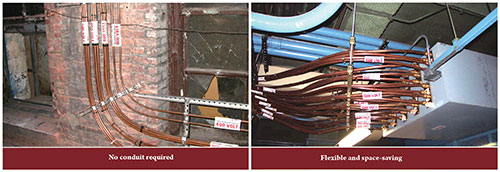In September 2012, both UL and ULC withdrew certification for Electrical Circuit Protective Systems (FHIT and FHITC) that employed fire resistive cables. This included UL Classified Fire Resistive Cable (FHJR), UL Listed cable with “-CI” suffix (Circuit Integrity), and ULC Listed Fire Resistant Cable (FHJRC). Certification was retained for systems that used protective materials like intumescent wraps, tapes, composite mats, etc.
Fire resistive cables are used for emergency circuits in many applications, including high-rise buildings and places of assembly. Emergency circuits include feeders for fire pumps, elevators, smoke control equipment, fire alarm systems and other similar circuits. These circuits are required by the National Electrical Code and the Canadian National Building Code to have a 2-hour fire rating. This added level of survivability is intended to allow sufficient time for building occupants to exit a building during an emergency and to provide uninterrupted power for fire fighting equipment and emergency communication systems.

There are two types of fire resistive power cable systems: polymer insulated cables that require conduit protection and armored cables that do not. Armored cable types include both mineral-insulated and metal-clad cable. The events that led to the certification withdrawal were based on systems employing polymer insulated cables, not armored cable.
In 2011, UL was informed of an issue with using polymer insulated fire-resistive cables in conduit systems coated with zinc. UL confirmed that a problem existed and issued a notice stating that fire-resistive cables should be used only with components free of zinc. UL expanded their research and conducted extensive additional testing that showed an unacceptable level of variability with all non-armored polymer insulated cables.
These findings led to the conservative decision to withdraw all certifications, including armored cable systems, even though there was no indication that similar issues existed with either metal-clad or mineral-insulated cables. Shortly thereafter, however, UL offered an interim test program to manufacturers of fire-resistive cable for possible re-certification of existing products.
After UL/ULC withdrew all fire resistive cable certifications, a joint meeting of the UL Standard Technical Panel on Fire Resistive Cables and the ULC Standards Committee on Fire Tests was arranged. The meeting took place on October 24, 2012, in Ottawa, Canada, where the committee reviewed available information and agreed to form task groups to evaluate and update the fire resistance test standards for cable systems. This process will include additional testing and review, and a revised standard is likely to take at least two years to complete.
Because mineral-insulated cable construction is completely different from the cable-in-conduit technology under investigation, UL/ULC worked with Pentair Thermal Management to reinstate Pyrotenax mineral-insulated cable as a 2-hour fire-rated cable system. The process included reviewing MI cable designs in detail, detailed technical explanations of the critical design factors related to mineral-insulated cable’s fire resistance, and extensive fire tests, in accordance with the interim test program performed at the UL facility in November and December of 2012.
On December 21, 2012, UL and ULC re-established certification of fire-resistive cables used in electrical circuit integrity systems. The first system to be included is Pyrotenax Mineral Insulated Cable, and it has been assigned a new identification: System No. 1850. Information can be found at www.ul.com in the Online Certifications Directory.










Find Us on Socials